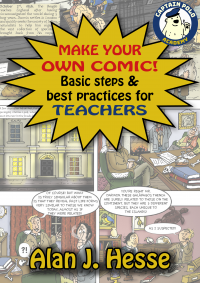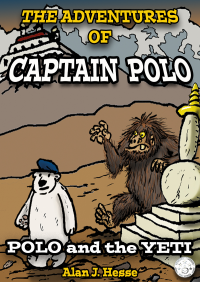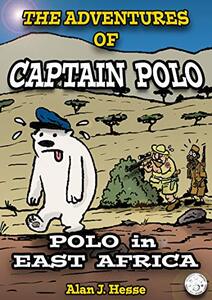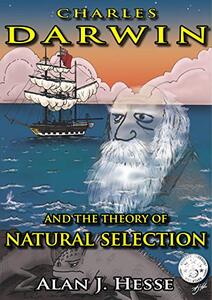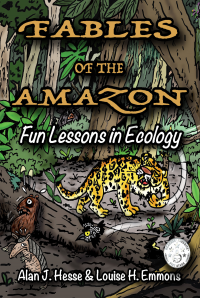Alan J. Hesse Interview Published on: 30, Jun 2021
 Where were you born and how has it affected you?
Where were you born and how has it affected you?
Lahore, Pakistan. My family, though European, has always had a strong international background, and I have lived most of my life in various countries commonly considered as part of the ‘developing world’. This rich experience has endowed me with a love for travel and deep respect and understanding for the different cultures around the world. I love to bring these out in my graphic novels, through setting, cultural idiosyncrasies and language.
What books do you remember reading during your childhood?I read a lot as a kid, because where I lived there was no TV and this was way before internet existed. I loved reading the original Tarzan novels, Asterix, Tintin, Lucky Luke and Archie comics, and anything by Enid Blyton. I also loved the ‘William’ books by Rachmel Crompton. I loved books about adventure, such as the Hardy Boys series, and I enjoyed reading the British ‘Commando’ comics about WWII.
What hobby do you miss most from your childhood? Why?Playing football (soccer). Soccer was my passion as a kid and I did little else (except read). In fact I loved it so much I would play by myself against a wall after playing with my friends at school.
Your thoughts on conventional vs. self-publishing? What route did you choose and why?I have been published conventionally but one reason I now go mostly with self-publishing is because I found out that publishers will very rarely promote and market books by unknown authors, so you end up having to do all that yourself anyway. Why relinquish most of your profits to a publisher who doesn’t even market your book for you?
The other reason why I currently self-publish is because I need to publish my books fast. My current focus with my graphic novels is climate change, a very fast-moving subject in terms of the concepts, terminology and global trends. What is considered gospel truth today may be discarded in 6 months. I can’t afford to wait for a publishing deal that may take years to put my books on shelves, becauseon the one hand the Earth is burning (the subject I communicate about is urgent) and also in that time my content will become outdated. My aim is to spread messages about environmental responsibility and climate action to as many people as fast as possible: the only way I can do that, barring a quick publishing deal with a publisher that understands and aligns with my mission enough to actively put my books in front of the right readers, is to self-publish.
What are some good books to read for an aspiring conservation biologist?There are many! One that stands out for me is the “Sand County Almanac” by Aldo Leopold. That is a very inspiring book because it reveals the spiritual connection one can have with pristine nature.
“The Greatest Show on Earth” by Richard Dawkins is of a more technical nature without being a text book, and it’s a wonderful overview to the wonder of biodiversity. Like I say, there are many. Those two are the ones that come to mind right now. The main thing is to avoid picking up a text book. The idea of conservation has to inspire you.
In what ways do you think your technical experience and knowledge to create scientifically accurate has helped you with your creativity?My technical knowledge provides the backdrop, the justification, the ‘why’ of my creative work. I want to express technical things about the things I know and care about in a way that is fun, different, engaging, entertaining. I draw upon my technical knowledge, decades of conservation experience and my extensive professional networks to create the framework for my creative process. The framework is science, what’s inside the framework is creativity – story telling, humor, adventure and fiction. The trick is to combine it all in a compelling graphic narrative without leaning too much one way or the other.
What makes something funny?It’s a big question. Humor comes with surprise, and in a comic or cartoon you can make that extreme, even to the point of defying the laws of Nature and physics. So a cow wearing pajamas is funny, for example, as are also impossible situations like we see in Looney Tunes cartoons. These are funny because they are unexpected. Satire is also funny, for an older audience. Also when the content strikes a chord that resonates with you personally, when you recognize the situation being described as one you often undergo yourself and the humorist points out something ridiculous about that situation. Stand-up comedians all use this approach. In my case, I like to use humor to depict stereotypes, cultural idiosyncrasies, and also slapstick situations where there is utter chaos.
What inspires you to write non-fiction graphic novels for middle grade children?My graphic novels are actually fiction, because though they contain a lot of factual information, the plot and characters are fictional. I find this inspiring because the fiction allows me to elevate my description of facts – some of which may be very daunting about tough subjects – to the magic of storytelling. This allows me to play with humor, action, adventure and keep things fast-paced and entertaining, all the while delivering important non-fiction information. I am inspired by the marriage between science and art, which I believe have always belonged together.
How much did you research about climate change while writing your Captain Polo series?A great deal. On average it takes about 3 or 4 months to do my research, sometimes longer. The research for Books 1 to 3, which I originally had published traditionally in a single book, took a full year. My research includes not only reading scientific articles but also doing personal interviews with subject matter experts, particularly for specific aspects of my content that I’m not sure about. I also do a lot of geographical and cultural research. The non-Latin languages that appear written in my books are all 100% authentic, the product of online research and the use of Google translate! I go into great detail on things like this: for example, in Book 3 of the Captain Polo series the Arabic that appears is not generic Arabic: the setting is Egypt, and the Arabic I use is Egyptian Arabic.
What challenges did you face while writing the book, Captain Polo's Christmas Activity Book?Making the puzzles! I had to get very creative to create coherent crossword puzzles and word mazes. It was a lot of fun. The other challenge of course is the technical nature of the words in those puzzles. The games are designed for kids as young as 6, yet the terms and concepts I’m asking them to find and play with require further explanation. This was very challenging.
What are some common mistakes new graphic artists make?I don’t really know, but one of the mistakes I made was to not plan my storyboard out well enough. I learned the hard way, but initially I wouldn’t plan out details like the order of the dialogues and what that implied for the placing of speech bubbles in each panel. I lost a lot of time with mistakes like that.
Which one is harder to use? Adobe Photoshop or Adobe Illustrator?I think Photoshop, though I actually use that a lot more than Illustrator. It took me years to learn and I’m still learning!
What can technology do to preserve nature, wildlife, and its animals?Technology can help humans use natural resources more efficiently, so that fewer natural resources are needed per person. Humans are by nature both innovative and lazy. We seek to make our lives easier, we abhor effort, especially unnecessary effort. Think of the TV control: it serves no purpose other than to save us from getting up from the couch. The right tech can harness this human tendency for the good of Nature, by saving energy, and cutting down on waste. Ideally, tech can also help us consume less.
What are your plans for the future as a writer? Are you working on anything new?My first order of business is to make Book 5 in the Captain Polo series. This is the sequel to Book 4, ‘Pole to Pole’ and it will be called ‘Antarctica’. I also plan to create other Polo books that are not graphic novels: perhaps another picture book, and a new activity book. As an author I want to change the book industry so that educational comics and graphic novels are mainstream, recognized in their own genre, and readers appreciate them for the value they can bring. Within a few years I want my character Captain Polo to be a household name, as well known and loved as Paddington Bear or Winnie the Pooh.
How has your experience with AllAuthor been?Excellent! I think it’s a great platform and I wish I’d known about it sooner.
Share Alan J. Hesse's interview
Alan J. Hesse was born in Lahore, Pakistan. As a kid, he loved playing football and read a lot. He is the author and illustrator of five non-fiction graphic novels for middle-grade children. He loves to bring out his rich experiences of different cultures in his graphic novels. His technical knowledge provides the backdrop, the justification, the ‘why’ of his creative work.
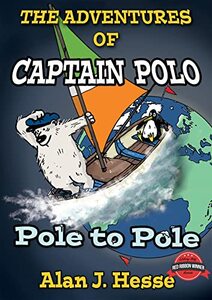 The Adventures of Captain Polo (Book 4): Pole to Pole: A stunningly illustrated, adventure-packed and humorous, educational graphic novel for kids 9 - 12 (perfect for reluctant readers)
Genre: Children's
The Adventures of Captain Polo (Book 4): Pole to Pole: A stunningly illustrated, adventure-packed and humorous, educational graphic novel for kids 9 - 12 (perfect for reluctant readers)
Genre: Children's
 The Adventures of Captain Polo: Books 1, 2 & 3: The Climate Change Comic / Captain Polo and the Yeti / Captain Polo in East Africa
Genre: Children's
The Adventures of Captain Polo: Books 1, 2 & 3: The Climate Change Comic / Captain Polo and the Yeti / Captain Polo in East Africa
Genre: Children's
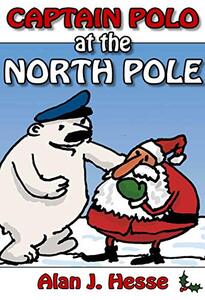 Captain Polo at the North Pole: A children's picture book about Christmas... with a very important message! For ages 6 to 9
Genre: Children's
Captain Polo at the North Pole: A children's picture book about Christmas... with a very important message! For ages 6 to 9
Genre: Children's
 Captain Polo's Christmas Activity Book: Educational fun for kids aged 6-12 (The Adventures of Captain Polo)
Genre: Children's
Captain Polo's Christmas Activity Book: Educational fun for kids aged 6-12 (The Adventures of Captain Polo)
Genre: Children's
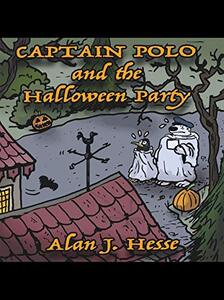 Captain Polo and the Halloween Party: A humorous story with a positive message. Ages 6 to 8. (The Adventures of Captain Polo)
Genre: Children's
Captain Polo and the Halloween Party: A humorous story with a positive message. Ages 6 to 8. (The Adventures of Captain Polo)
Genre: Children's

